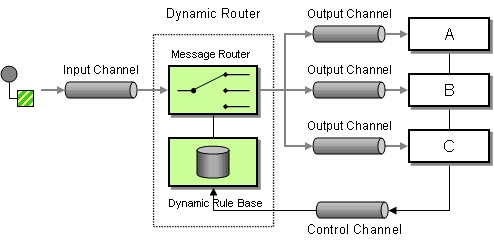THIS IS A TEST INSTANCE. ALL YOUR CHANGES WILL BE LOST!!!!
| Wiki Markup |
|---|
h2. Dynamic Router |
...
The [Dynamic Router|http://www.enterpriseintegrationpatterns.com/DynamicRouter.html] from the [EIP patterns|Enterprise Integration Patterns] allows you to route messages while avoiding the dependency of the router on all possible destinations while maintaining its |
...
...
efficiency. !http://www.enterpriseintegrationpatterns.com/img/DynamicRouter.gif! In *Camel 2.5* we introduced a {{dynamicRouter}} in the DSL which is like a dynamic [Routing Slip] which evaluates the slip _on-the-fly_. |
...
| Warning | ||
|---|---|---|
| ||
You must ensure the expression used for the |
Dynamic Router in Camel 2.5 onwards
...
{warning:title=Beware} You must ensure the expression used for the {{dynamicRouter}} such as a bean, will return {{null}} to indicate the end. Otherwise the {{dynamicRouter}} will keep repeating endlessly. {warning} h3. Options {div:class=confluenceTableSmall} || Name || Default Value || Description || | {{uriDelimiter}} | {{,}} | Delimiter used if the [Expression] returned multiple endpoints. | | {{ignoreInvalidEndpoints}} | {{false}} | If an endpoint uri could not be resolved, should it be ignored. Otherwise Camel will thrown an exception stating the endpoint uri is not valid. | {div} h3. Dynamic Router in Camel 2.5 onwards From Camel 2.5 the [Dynamic Router] will set a property (Exchange.SLIP_ENDPOINT) on the [Exchange] which contains the current endpoint as it advanced though the slip. This allows you to know how far we have processed in the slip. (It's a slip because the [Dynamic Router] implementation is based on top of [Routing Slip]). |
...
h4. Java DSL |
...
In Java DSL you can use the {{routingSlip}} as shown below: |
...
| Wiki Markup |
|---|
{snippet:id=e1|lang=java|url=camel/trunk/camel-core/src/test/java/org/apache/camel/processor/DynamicRouterTest.java} Which will leverage a [Bean] to compute the slip _on-the-fly_, which could be implemented as follows: |
...
| Wiki Markup |
|---|
{snippet:id=e2|lang=java|url=camel/trunk/camel-core/src/test/java/org/apache/camel/processor/DynamicRouterTest.java} Mind that this example is only for show and tell. The current implementation is not thread safe. You would have to store the state on the Exchange, to ensure thread safety. |
...
Spring XML
The same example in Spring XML would be:
| Wiki Markup |
|---|
h4. Spring XML The same example in Spring XML would be: {snippet:id=e1|lang=xml|url=camel/trunk/components/camel-spring/src/test/resources/org/apache/camel/spring/processor/SpringDynamicRouterTest.xml} h4. @DynamicRouter annotation |
...
You can also use the {{@DynamicRouter}} annotation, for example the Camel 2.4 example below could be written as follows. The {{route}} method would then be invoked repeatedly as the message is processed dynamically. The idea is to return the next endpoint uri where to go. Return {{null}} to indicate the end. You can return multiple endpoints if you like, just as the [Routing Slip], where each endpoint is separated by a delimiter. |
...
{code | ||
:java | java | } public class MyDynamicRouter { @Consume(uri = "activemq:foo") @DynamicRouter public String route(@XPath("/customer/id") String customerId, @Header("Location") String location, Document body) { // query a database to find the best match of the endpoint based on the input parameteres // return the next endpoint uri, where to go. Return null to indicate the end. } } {code} h3. Dynamic Router in Camel 2.4 or older |
...
The simplest way to implement this is to use the [RecipientList Annotation] on a Bean method to determine where to route the message. |
...
{code | ||
:java | java | } public class MyDynamicRouter { @Consume(uri = "activemq:foo") @RecipientList public List<String> route(@XPath("/customer/id") String customerId, @Header("Location") String location, Document body) { // query a database to find the best match of the endpoint based on the input parameteres ... } } {code} In the above we can use the [Parameter Binding Annotations] to bind different parts of the [Message] to method parameters or use an [Expression] such as using [XPath] or [XQuery]. |
...
The method can be invoked in a number of ways as described in the [Bean Integration] such as |
...
* [POJO Producing |
...
] * [Spring Remoting |
...
]
* [Bean] component
{include:Using This Pattern} |
